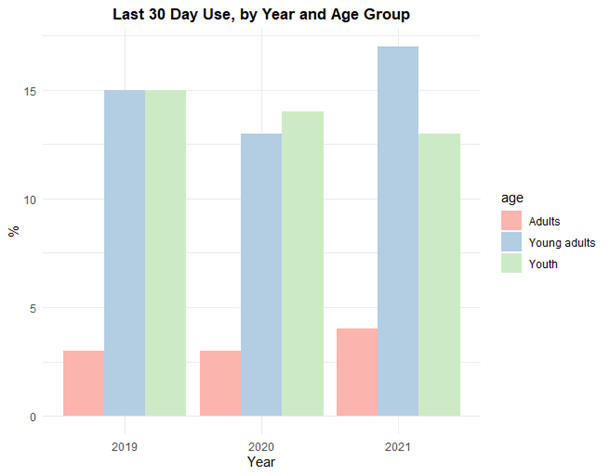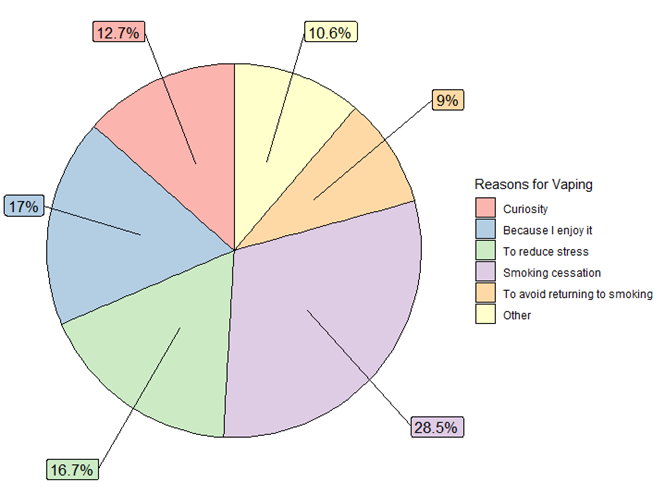Statistics & Research
Vaping Rates
According to recent results from the 2021 Canadian Tobacco and Nicotine Survey, vaping continues to be more prevalent among younger age groups. In 2021, 13% of youth and 17% of young adults had vaped in the past 30 days, compared to 4% of adults.

Figure: Percentage of respondents who reported vape use over the past 30 days, by year and age group, 2019-2021 [Canadian Tobacco and Nicotine Surveys].
Youth and adult vaping rates remained mostly stable from 2019 to 2021, despite pandemic-related disruptions. The proportion of young adults who reported using a vaping device in the past 30 days increased from 2020 to 2021. Restrictions related to the COVID-19 pandemic may have made it more difficult for youth to obtain vapes, as research shows the majority of youth obtain vaping devices from a social source. As restrictions lift, it’s possible vaping rates will climb.
Reasons for Vaping
The proportion of youth who reported vaping to reduce stress increased from 2019 to 2021. This may indicate that youth are vaping to reduce stress caused by the pandemic and related disruptions. Youth also reported vaping because they enjoyed it and because they wanted to try it. In 2020, among all age groups, the most common reason for vaping was smoking cessation, followed by enjoyment and stress reduction.
Reasons for Vaping (all age groups), 2020

The most common reasons for vaping reported by young adults in Canada were: because they enjoyed it, to reduce stress, and to reduce, quit, or avoid returning to smoking. Among adults aged 25 and older, a majority cited their main reason for vaping as to reduce, quit, or avoid returning to smoking.
Fruit, mint, and menthol were the most popular vaping flavours in 2021. Research shows that certain flavourings contained in e-liquids are especially appealing to youth: 65% of youth prefer fruit flavours, compared to 57% of young adults and 48% of older adults. As youth have an increased risk of nicotine addiction and suffer more health effects related to vaping, the government of Canada has placed restrictions on the promotion of vaping flavours that appeal to youth (including fruit, candy, and dessert).
Sources of Vaping Devices
In a 2021 survey, among youth who reported using a vaping device in the past 30 days, just over half reported using a social source to get their vaping device. Social sources include buying/borrowing from a friend or family member or asking someone else to buy the device. 78% of young adults and 92% of adults who used a vaping device in the past 30 days reported obtaining their vaping device from a retail source.
Vaping to Quit Smoking
In 2021, most surveyed adults over 25 who vape reported that their main reason for vaping was to reduce, quit, or avoid returning to smoking. However, among youth who reported having vaped in the last 30 days, most had never smoked a cigarette. This indicates that younger demographics are vaping for reasons other than quitting or reducing their tobacco use.
Although many adults begin vaping to reduce, quit, or avoid returning to smoking, one study found that approximately 70% of those who vape also smoke cigarettes. This is called dual use, and while it may seem like a good way to cut back on smoking, dual use is associated with a higher risk of cardiovascular disease, obesity, and various psychosocial and behavioural risk factors.
In 2020, most surveyed youth and nearly half of young adults who used a vape daily reported making at least one attempt to quit vaping. Visit Ready to Quit for more information about quitting vaping.
References
- Coleman, B. N., Rostron, B., et al. (2017). Electronic cigarette use among US adults in the Population Assessment of Tobacco and Health (PATH) Study, 2013-2014. Tobacco control, 26(e2), e117–e126. https://doi.org/10.1136/tobaccocontrol-2016-053462
- Kim, C. Y., Paek, Y. J., Seo, H. G., Cheong, Y. S., Lee, C. M., Park, S. M., Park, D. W., & Lee, K. (2020). Dual use of electronic and conventional cigarettes is associated with higher cardiovascular risk factors in Korean men. Scientific reports, 10(1), 5612. https://doi.org/10.1038/s41598-020-62545-3
- Statistics Canada. (2019). Canadian Tobacco and Nicotine Survey (CTNS) 2019. Statistics Canada. https://www.canada.ca/en/health-canada/services/canadian-tobacco-nicoti…
- Statistics Canada. (2020). Canadian Tobacco and Nicotine Survey (CTNS) 2020. Statistics Canada. https://www.canada.ca/en/health-canada/services/canadian-tobacco-nicoti…
- Statistics Canada. (2022). Canadian Tobacco and Nicotine Survey (CTNS) 2021. Statistics Canada. https://www150.statcan.gc.ca/n1/daily-quotidien/220505/dq220505c-eng.htm
